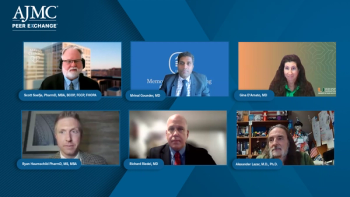
Myelofibrosis May Predict Extramedullary Disease in MM
The researchers found that extramedullary disease at diagnosis was significantly more common in patients with bone marrow fibrosis.
Having myelofibrosis (MF) may predict the risk of developing multiple myeloma (MM) cells outside the bone marrow, according to
The findings come from 91 Japanese patients newly diagnosed with MM, from whom researchers found that extramedullary disease at diagnosis was significantly more common in patients with bone marrow fibrosis.
According to the researchers, their study, which took a broad look at the effect of bone marrow fibrosis on clinical characteristics and treatment outcomes, is the first to determine such impact in patients with MM who have an Asian background.
“We statistically confirmed the higher incidence of extramedullary disease in MM patients with bone marrow fibrosis,” explained the researchers. “In solid cancer, progression of the fibrotic tumor microenvironment is one of the important steps for metastasis of cancer cells. Together with this widely accepted notion, our present observation suggests that the development of bone marrow fibrosis is also important for extramedullary dissemination of MM cells.”
Among the patients, 37% had bone marrow fibrosis that was greater than grade 1, which the researchers said is in line with previous studies. These patients were more likely to have extramedullary disease at initial presentation compared with patients without fibrosis. There were 5 patients with extramedullary multiple myeloma documented in the study, 1 of which exhibited MF-3 levels while 4 had MF-1 level fibrosis.
Patients with bone marrow fibrosis had lower expression levels of CD49e on their myeloma cells compared with those of patients without fibrosis. According to the researchers, this may suggest that downregulation of adhesion molecules, such as CD49e, may promote MM cells spreading outside the bone marrow environment and causing extramedullary multiple myeloma.
Meanwhile, having bone marrow fibrosis carried no implications for survival, engraftment after autologous hematopoietic stem cell transplantation, or response to initial treatment. Rates of very good partial response or better were 28.1% among patients without fibrosis and 44.1% among patients with fibrosis.
“It is unclear whether the bone marrow fibrosis observed in MM patients is reversible with treatment,” wrote the researchers, adding, “In our study, we found that 5 of 7 patients who underwent a second bone marrow biopsy showed regression of bone marrow fibrosis, and it should be noted that a patient with regression of fibrosis achieved stringent complete response (sCR) at the second examination. Altogether, it is speculated that bone marrow fibrosis shown in MM could be resolved after treatment for MM.”
The researchers also found that bone marrow fibrosis had no effect on laboratory data, the percentage of plasma cells in bone marrow, or cytogenic findings.
Reference
Koshiishi M, Kawashima I, Hyuga H, et al. Presence of bone marrow fibrosis in multiple myeloma may predict extramedullary disease. Int J Hematol. Published online May 10, 2020. doi:10.1007/s12185-022-03373-1
Newsletter
Stay ahead of policy, cost, and value—subscribe to AJMC for expert insights at the intersection of clinical care and health economics.












































